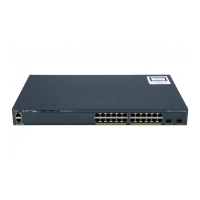1-17
Catalyst 2960 and 2960-S Switches Software Configuration Guide, Release 15.0(1)SE
OL-26520-01
Chapter 1 Overview
Default Settings After Initial Switch Configuration
Default Settings After Initial Switch Configuration
The switch is designed for plug-and-play operation, requiring only that you assign basic IP information
to the switch and connect it to the other devices in your network. If you have specific network needs,
you can change the interface-specific and system- and stack-wide settings.
Note For information about assigning an IP address by using the browser-based Express Setup program, see
the getting started guide. For information about assigning an IP address by using the CLI-based setup
program, see the hardware installation guide.
If you do not configure the switch at all, the switch operates with these default settings:
• Default switch IP address, subnet mask, and default gateway is 0.0.0.0. For more information, see
Chapter 3, “Assigning the Switch IP Address and Default Gateway,” and Chapter 20, “Configuring
DHCP and IP Source Guard Features.”
• Default domain name is not configured. For more information, see Chapter 3, “Assigning the Switch
IP Address and Default Gateway.”
• DHCP client is enabled, the DHCP server is enabled (only if the device acting as a DHCP server is
configured and is enabled), and the DHCP relay agent is enabled (only if the device is acting as a
DHCP relay agent is configured and is enabled). For more information, see Chapter 3, “Assigning
the Switch IP Address and Default Gateway,” and Chapter 20, “Configuring DHCP and IP Source
Guard Features.”
• Switch stack is enabled (not configurable). For more information, see Chapter 7, “Managing Switch
Stacks.”
• Switch cluster is disabled. For more information about switch clusters, see Chapter 6, “Clustering
Switches,” and the Getting Started with Cisco Network Assistant, available on Cisco.com.
• No passwords are defined. For more information, see Chapter 5, “Administering the Switch.”
• System name and prompt is Switch. For more information, see Chapter 5, “Administering the
Switch.”
• NTP is enabled. For more information, see Chapter 5, “Administering the Switch.”
• DNS is enabled. For more information, see Chapter 5, “Administering the Switch.”
• TACACS+ is disabled. For more information, see Chapter 9, “Configuring Switch-Based
Authentication.”
• RADIUS is disabled. For more information, see Chapter 9, “Configuring Switch-Based
Authentication.”
• The standard HTTP server and Secure Socket Layer (SSL) HTTPS server are both enabled. For more
information, see Chapter 9, “Configuring Switch-Based Authentication.”
• IEEE 802.1x is disabled. For more information, see Chapter 10, “Configuring IEEE 802.1x
Port-Based Authentication.”
• Port parameters
–
Interface speed and duplex mode is autonegotiate. For more information, see
–
Auto-MDIX is enabled. For more information, see
–
Flow control is off. For more information, see
–
PoE is autonegotiate. For more information, see

